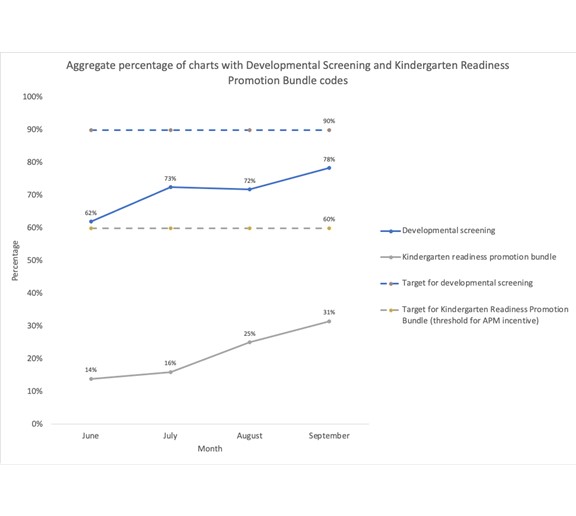General Pediatrics
Session: General Pediatrics 4
367 - Promoting Kindergarten Readiness in Pediatric Primary Care Practices Using a Multi-Center, Longitudinal Learning Collaborative Model
Saturday, May 4, 2024
3:30 PM - 6:00 PM ET
Poster Number: 367
Publication Number: 367.1257
Publication Number: 367.1257

Jessica Young, MD, MPH (she/her/hers)
Assistant Professor of Pediatrics
University of North Carolina at Chapel Hill School of Medicine
Durham, North Carolina, United States
Presenting Author(s)
Background: Kindergarten readiness is associated with many positive childhood outcomes, yet fewer than half of children nationally are kindergarten-ready. The Kindergarten Readiness Promotion Bundle (KRPB) was developed as a novel quality metric of the Alternative Payment Model (APM) of NC Integrated Care for Kids (NC InCK), a CMS-funded pilot program to improve whole-child health. The KRPB consists of at least 5 actions at well visits including developmental and social-emotional screening, literacy promotion, fluoride varnish, early intervention, mental health, and parenting referrals.
Objective: We sought to support practices in implementing the KRPB within NC InCK’s Alternative Payment Model (APM) by utilizing a new KRPB code designated by NC Medicaid, and to optimize the implementation of selected bundle components.
Design/Methods: We launched a learning collaborative consisting of quality improvement (QI) support, data feedback, and monthly topic-focused webinars for practices across three health systems. The overall aim was to increase the percentage of children birth to age 6 receiving the KRPB during well visits from 0% to 60%. Practices were provided relevant QI tools following the Model for Improvement and Plan-Do-Study-Act (PDSA) methodology. Practices submitted monthly data on the use of the KRPB code and its components including developmental screening, social-emotional screening, fluoride varnish application, and in-office literacy promotion.
Results: Six practices submitted monthly data. Overall KRPB implementation increased from 14% to 31% (+17%). Specific components of the bundle increased from baseline to follow-up as follows: developmental screening 62% to 78% (+16%), social-emotional screening 27% to 44% (+17%), fluoride varnish application 20% to 24% (+4%), and in-office literacy promotion 75% to 82% (+7%), all p>0.10. Practice changes included adding QR codes with literacy resources to after visit summaries, implementing social-emotional screening, and having community agencies provide on-site resources.
Conclusion(s): A QI learning collaborative increased implementation of the KRPB and individual components of high quality well visits. Provider education, quick data feedback, and integrated community partnerships have been successful interventions to date. Future work is needed to determine the impact of primary care-based kindergarten readiness promotion efforts on children and families, including on measured kindergarten readiness rates.
.jpg)

